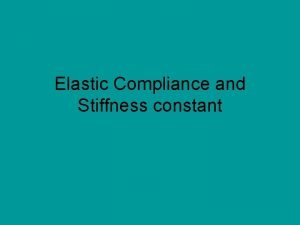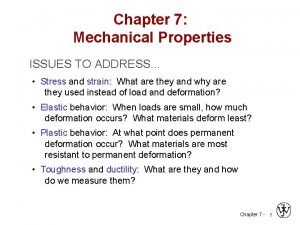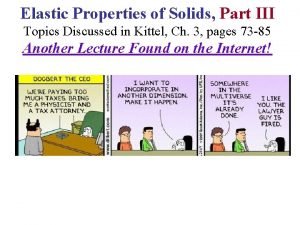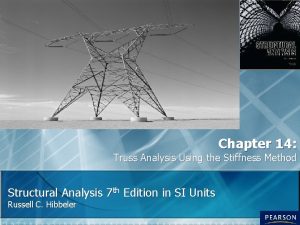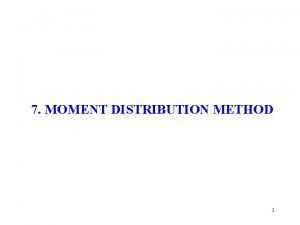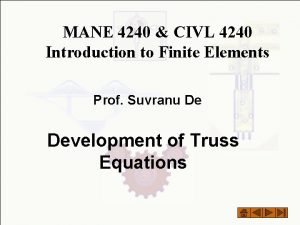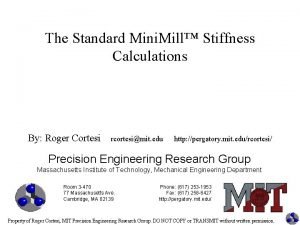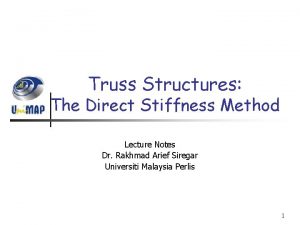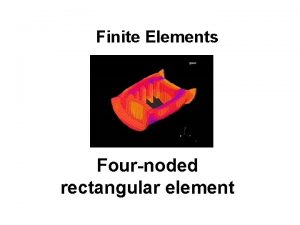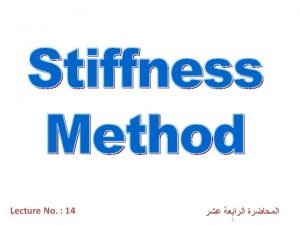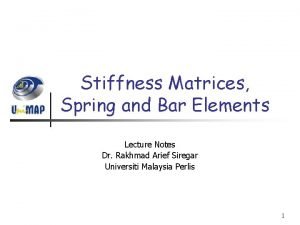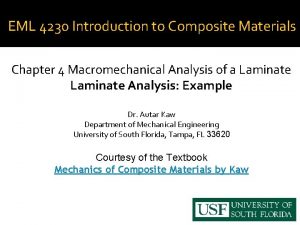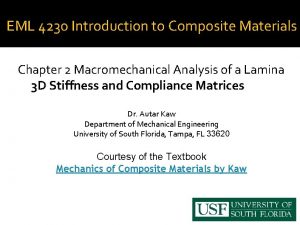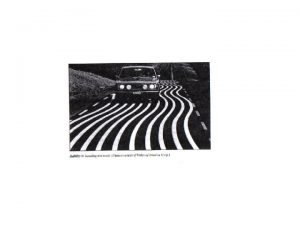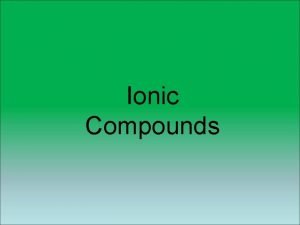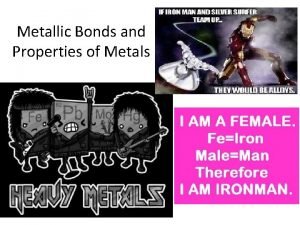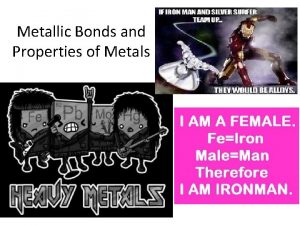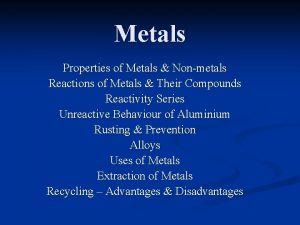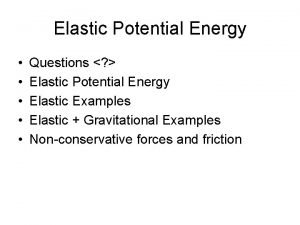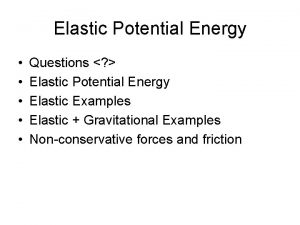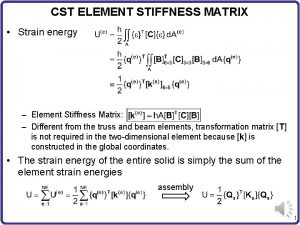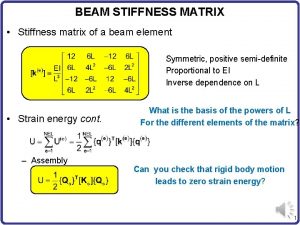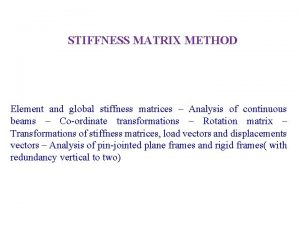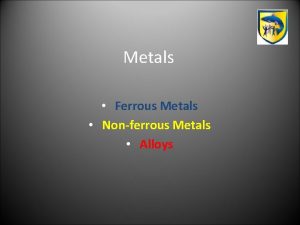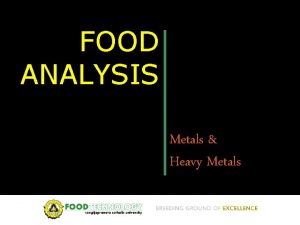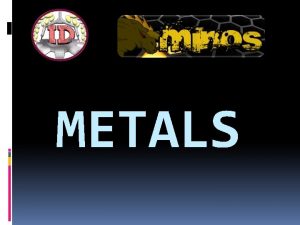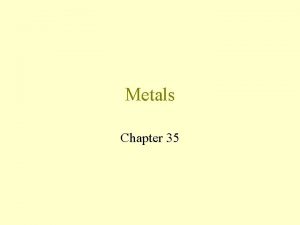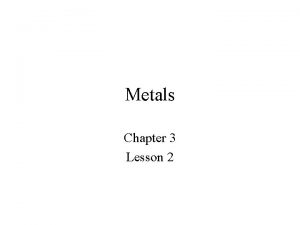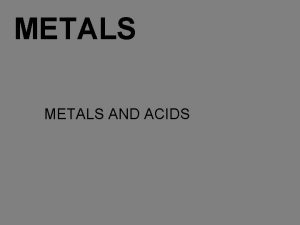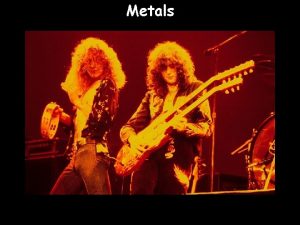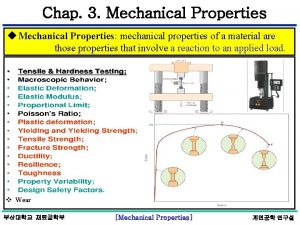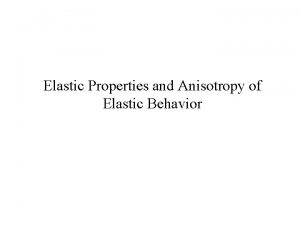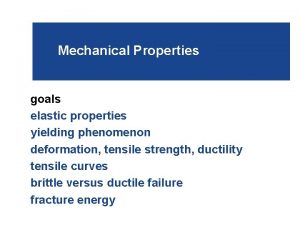Mechanical Properties of Metals Mechanical Properties Stiffness Elastic


























- Slides: 26

Mechanical Properties of Metals

Mechanical Properties • Stiffness - Elastic Modulus or Young’s Modulus (MPa) • Strength - Yield, Ultimate, Fracture, Proof, Offset Yield. Measured as stress (MPa) • Ductility - Measure of ability to deform plastically without fracture - Elongation, Area Reduction, Fracture Strain - (no units or mm/mm) • Toughness, Resilience - Measure of ability to absorb energy (J/m 3). • Hardness - Resistance to indentation/abrasion (Various scales, e. g. ; Rockwell, Brinell, Vickers. )

Stress and Strain • In a simplistic sense, stress may be thought of as Load/Area. • Similarly, strain is the deformation of the component/original length. • A stress may be direct, shear, or torsional leading to corresponding deformations. • Stress cannot be measured directly, but deformation can be.

Direct Stress Examples Engineering Stress Engineering Strain Direct Stress - Tension Direct Stress - Compression

Tension Test Measures P Extensometer Measures DL Typical Universal Testing Machine

Modern Materials Testing System Hydraulic Wedge Grips Extensometer Specimen

ASTM Tension Test Specimen Ao=0. 20 in 2 2” Gauge Length Lo

Raw Data Obtained Load, P (k. N) Total Elongation Uniform Deformation X Maximum Load, Pmax Elastic Deformation Elongation, DL (mm) Load, Pf

Engineering Stress-Strain Curve Engineering Stress, S=P/Ao Elongation Sy 0. 2% offset yield stress (Ultimate) E Su E Proportional Limit Engineering Strain, e = DL/Lo)

Duke’s Quick Tip! • Express Load in Newtons (N) and Area in mm 2 to get Stress in MPa. • Mechanical properties of metals are almost always given in MPa or ksi. • Imperial units: Load in kips (1000 lbf) & Area as in 2 gives Stress in ksi (kips/in 2) • 1000 psi = 1 ksi = 6. 89 MPa

Hooke’s Law Elastic Deformation • Elastic deformation is not permanent; it means that when the load is removed, the part returns to its original shape and dimensions. • For most metals, the elastic region is linear. For some materials, including metals such as cast iron, polymers, and concrete, the elastic region is non-linear. • If the behavior is linear elastic, or nearly linear-elastic, Hooke’s Law may be applied: • Where E is the modulus of elasticity (MPa)

Modulus of Elasticity - Stiffness

Atomic Origin of Stiffness

Shear Stress and Strain Shear Strain shear stress, t = Shear Load / Area shear strain, g = angle of deformation (radians) shear modulus, G = t /g (elastic region)

Elastic Properties of Materials • Poisson’s ratio: When a metal is strained in one direction, there are corresponding strains in all other directions. • For a uniaxial tension strain, the lateral strains are constrictive. • Conversely, for a uniaxial compressive strain, the lateral strains are expansive. • i. e. ; the lateral strains are opposite in sign to the axial strain. • The ratio of lateral to axial strains is known as Poisson’s ratio, n.

Poisson’s Ratio, n For most metals, 0. 25 < n < 0. 35 in the elastic range Furthermore:

Plastic Deformation Elastic Plastic Sy Sy Elastic Plastic Stress Sy 0. 002 Most Metals - Al, Cu 0. 002 Strain Clad Al-Alloys 0. 002 Low carbon Steel

Microstructural Origins of Plasticity • Slip, Climb and Slide of atoms in the crystal structure. • Slip and Climb occur at Dislocations and Slide occurs at Grain Boundaries. t t

Elastic and Plastic Strain Stress P (e, S) Total Strain Plastic ep ee Elastic The 0. 2% offset yield stress is the stress that gives a plastic (permanent) strain of 0. 002.

Elastic Recovery Loading Reloading Stress Loading Unloading Strain elastic strain Strain

Ductility - EL% & AR% • Elongation Lo Lf • Area Reduction Ao Af

Ductile Vs Brittle Materials Engineering Stress • Only Ductile materials will exhibit necking. • Ductile if EL%>8% (approximately) • Brittle if EL% < 5% (approximately) Engineering Strain

Toughness & Resilience • Toughness: A measure of the ability of a material to absorb energy without fracture. (J/m 3 or N. mm/mm 3= MPa) • Resilience: A measure of the ability of a material to absorb energy without plastic or permanent deformation. (J/m 3 or N. mm/mm 3= MPa) • Note: Both are determined as energy/unit volume

Engineering Stress, S=P/Ao Toughness, Ut Sy Su Engineering Strain, e = DL/Lo)

Engineering Stress, S=P/Ao Resilience, Ur Su Sy E ey Engineering Strain, e = DL/Lo)

Typical Mechanical Properties Metals in annealed (soft) condition
 Elastic strain and plastic strain
Elastic strain and plastic strain Elastic fibers
Elastic fibers Calister
Calister Ferrous material
Ferrous material Reactivity periodic table
Reactivity periodic table Compare metals nonmetals and metalloids
Compare metals nonmetals and metalloids Natural science grade 7 term 2 notes
Natural science grade 7 term 2 notes Metals metalloids and nonmetals periodic table
Metals metalloids and nonmetals periodic table Natural science grade 7 matter and materials
Natural science grade 7 matter and materials Elastic properties of solids
Elastic properties of solids Morning stiffness
Morning stiffness Truss stiffness matrix
Truss stiffness matrix Moment distribution table
Moment distribution table Direction cosines of truss element 2 are
Direction cosines of truss element 2 are Axial stifness
Axial stifness Stiffness matrix method lecture notes
Stiffness matrix method lecture notes Hamstring isotonic exercises
Hamstring isotonic exercises Stiffness matrix for 4 noded rectangular element
Stiffness matrix for 4 noded rectangular element Abcc137
Abcc137 Spring stiffness matrix
Spring stiffness matrix Stiffness matrix
Stiffness matrix Cst elements
Cst elements Orthotropic stiffness matrix
Orthotropic stiffness matrix Understeer
Understeer Rheumatoid arthritis vs osteoarthritis
Rheumatoid arthritis vs osteoarthritis Reactivity series
Reactivity series Non metals
Non metals
